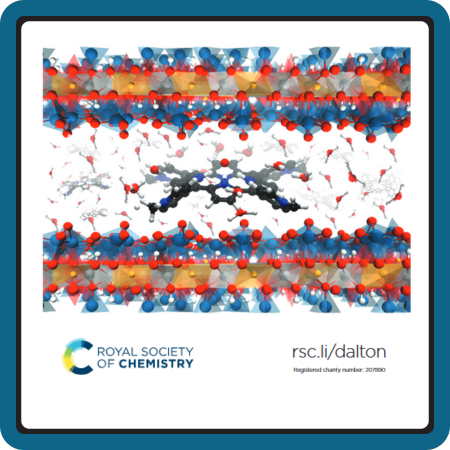 Dos autores Eduardo Diaz Suarez, Filipe Camargo Dalmatti Alves Lima, Arles V. Gil Rebaza, Vera Regina Leopoldo Constantino e Helena Maria Petrilli.
Dos autores Eduardo Diaz Suarez, Filipe Camargo Dalmatti Alves Lima, Arles V. Gil Rebaza, Vera Regina Leopoldo Constantino e Helena Maria Petrilli.
Publicado em Dalton Transactions. Back Cover do nº 6, 2025.
--
O artigo, originalmente publicado em 18/12/24, é resultado da tese de doutorado de Eduardo D. Suárez (primeiro autor) orientando da Profª. Helena Maria Petrilli. O trabalho agora ganha destaque como Back Cover do número 6 / 2025, no periódico Dalton Transactions, publicação da Royal Society of Chemistry.
Abstract:
Distortions in the porphyrin core from planarity can trigger a unique structure–property relationship, imparting its basicity, chemical stability, redox potential, and excited-state energetics, among other properties. The colour change promoted by such distortion is signed by red shifts in its electronic absorption spectra. The adsorption of guest meso-substituted free-base porphyrin species onto inorganic hosts, such as clay minerals (layered aluminium or magnesium silicates), is known to further promote colour changes. However, the origin of these changes remains a subject of debate without a clear consensus. In this work, an extensive theoretical study was conducted using density functional theory (DFT) to model the interactions between tetracationic porphyrins, specifically meso-substituted groups N-methyl-4-pyridyl (p-TMPyP) and N-methyl-3-pyridyl (m-TMPyP), and montmorillonite (MMT) with the ideal formula [(Al1.67Mg0.33)Si4O10(OH)2]−0.33. The following conditions were evaluated: (i) adsorption or intercalation of p-TMPyP into MMT host structure, (ii) intercalation of m-TMPyP into MMT, and (iii) the influence of water on the intercalation process. The electrostatic interactions between the porphyrins and the MMT siloxane surface induced conformational changes in p-TMPyP, characterized by rotation of the substituent groups at the macrocycle periphery and a twist of the porphyrin plane. The nonplanarity of the intercalated p-TMPyP guest produced robust Brønsted basic sites capable of abstracting H+ ions from intercalated water molecules, resulting in the formation of a dication. The macrocycle distortion was found to decrease π-conjugation, thereby enhancing the localisation of the lone pair on the imine nitrogen atom. On the other hand, m-TMPyP exhibited slight core macrocycle deformations and minor changes in the dihedral angles of its meso-substituent groups compared to its isomer, with no observed protonation reaction upon intercalation. These findings highlight the clay microenvironment as a promising strategy for inducing conformational alterations in porphyrins, promoting nonplanarity, and exemplifying a shape-responsive system within the framework of guest–host chemistry.
-> Acesse o artigo “Shape-responsive host–guest chemistry: metal-free tetracationic porphyrin nonplanarity promoted by clay mineral interactions assessed by theoretical simulations"

